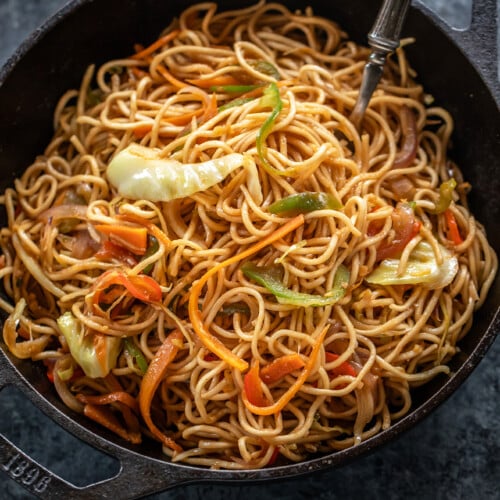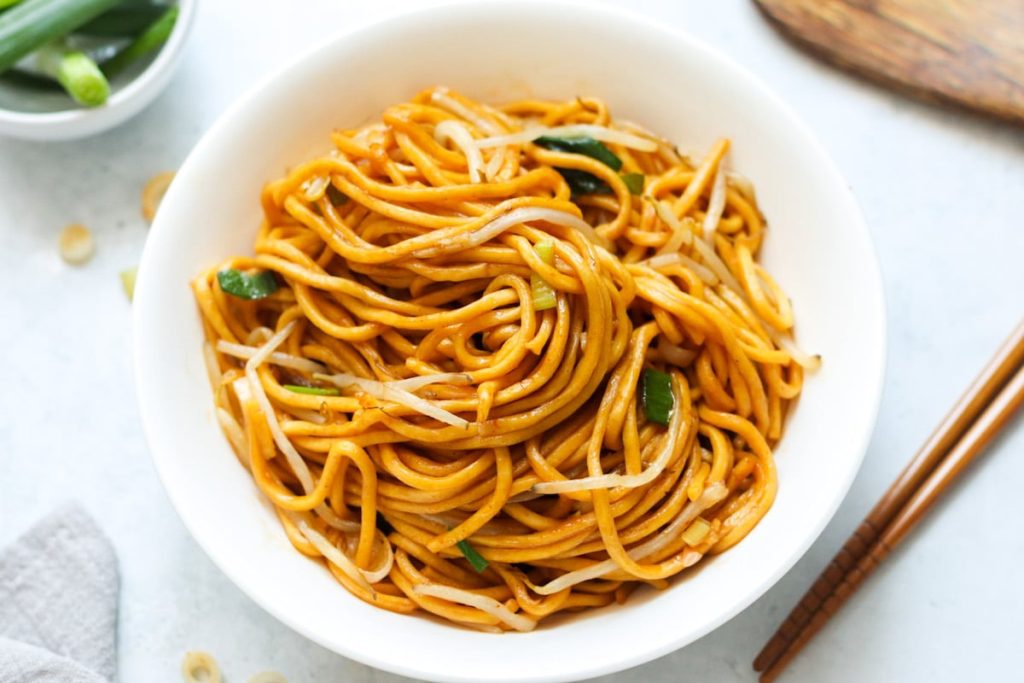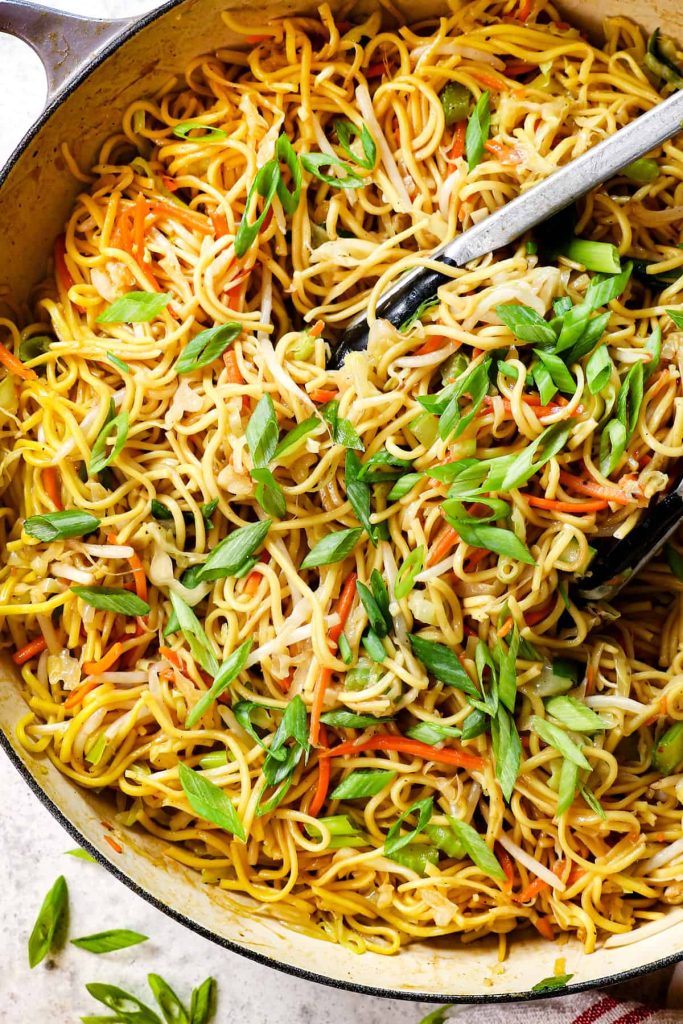Introduction:
How To Cook Chow Mein Noodles is a classic dish that has found its way into kitchens around the world, celebrated for its savory flavors, satisfying textures, and versatility. Cooking chow mein noodles at home allows you to tailor the dish to your preferences, whether you like it loaded with vegetables, packed with protein, or simply stir-fried with a perfect blend of seasonings. Here’s how to cook chow mein noodles that will rival your favorite takeout spot.

Ingredients You’ll Need:
Chow Mein Noodles: 8-10 ounces of fresh or dried chow mein noodles
Vegetables: 1 cup of shredded cabbage, 1 carrot (julienned), 1 bell pepper (sliced thinly), and a handful of bean sprouts
Protein (optional): 1 chicken breast (thinly sliced), ½ pound of shrimp, or tofu
Aromatics: 3 cloves garlic (minced), 1-inch piece of ginger (grated)
Sauce: 3 tablespoons soy sauce, 1 tablespoon oyster sauce, 1 tablespoon hoisin sauce, 1 teaspoon sesame oil, ½ teaspoon sugar
Cooking Oil: 2 tablespoons of vegetable oil or peanut oil
Step 1: Prepare the Noodles
Begin by cooking the chow mein noodles according to the package instructions. If you’re using dried noodles, boil them in a pot of water until they are just tender, usually about 2-3 minutes. Be careful not to overcook them; they should be al dente as they’ll continue cooking later when stir-fried.. Toss them with a small amount of oil to prevent sticking and set them aside.
Step 2: Prep Your Ingredients
While the noodles are cooking, prepare your vegetables and protein. Thinly slice the chicken, shrimp, or tofu if you’re adding protein to your dish. Julienne the carrot, slice the bell pepper, shred the cabbage, and have your bean sprouts ready. Mince the garlic and grate the ginger for added flavor.
Step 3: Make the Sauce
In a small bowl, mix together soy sauce, oyster sauce, hoisin sauce, sesame oil, and sugar. Adjust the seasoning to your taste—if you like it spicier, you can add a dash of chili sauce or red pepper flakes.
Step 4: Stir-Fry the Protein
Heat a wok or large skillet over medium-high heat and add a tablespoon of oil. Once the oil is hot, add your protein choice. Stir-fry until the protein is cooked through and slightly browned. Remove from the wok and set aside.
Step 5: Stir-Fry the Vegetables
In the same wok, add another tablespoon of oil. Add the garlic and ginger, stir-frying for about 30 seconds until fragrant. Then, toss in the vegetables, starting with the carrots and bell peppers, as they take longer to cook. Stir-fry for 2-3 minutes until they start to soften. Add the shredded cabbage and bean sprouts, cooking for another minute.
Step 6: Combine Noodles, Protein, and Vegetables
Add the cooked noodles and the protein back into the wok with the vegetables. Pour the sauce over the top and toss everything together using tongs or chopsticks, ensuring the noodles are well-coated with the sauce. Stir-fry for another 2-3 minutes, allowing the flavors to meld together and the noodles to soak up the sauce.
Step 7: Serve Your Chow Mein
Once everything is well-mixed and heated through, remove the chow mein from the heat. Serve it hot, garnished with chopped green onions or a sprinkle of sesame seeds for an extra touch of flavor and presentation.
Tips for Perfect Chow Mein:
Noodle Choice: Fresh chow mein noodles give the best texture, but dried noodles work well too if cooked properly.
High Heat Cooking: Keep your wok or skillet at high heat for a quick and efficient stir-fry. This helps to achieve that characteristic wok hei, or “breath of the wok,” which gives chow mein its authentic flavor.
Customize Your Chow Mein: Feel free to add your favorite vegetables, swap out proteins, or even go vegetarian. The sauce is versatile and works well with many variations.
With this guide, you can now whip up a delicious batch of chow mein noodles in your own kitchen, bringing a taste of the takeout classic to your dinner table. Enjoy experimenting with different ingredients and find your perfect version of this beloved dish.
How do chow mein noodles taste?
Chow mein noodles are a cornerstone of Chinese cuisine, known for their delightful texture and savory taste that make them a favorite in many households and restaurants. Whether you’re enjoying them in a bustling Chinatown eatery or cooking them at home, the taste of chow mein noodles is a harmonious blend of flavors and textures that create a satisfying culinary experience.
1.The Texture: A Perfect Balance
One of the most defining characteristics of chow mein noodles is their texture. When cooked correctly, these noodles have a slightly chewy, firm bite that contrasts beautifully with the crispness of stir-fried vegetables or the tenderness of added proteins like chicken or shrimp. The noodles are typically pan-fried, which gives them a subtle crispness on the edges, adding to the overall texture and making each bite interesting.
The texture of chow mein noodles can vary slightly depending on how they are prepared. In some versions, particularly those found in Westernized Chinese cuisine, the noodles might be fried until they’re fully crispy, offering a crunch that plays against the softer ingredients. In other variations, particularly more traditional or homemade styles, the noodles retain a softer, yet still firm, chewiness that absorbs the flavors of the sauce and stir-fry.
2.The Flavor: A Savory Symphony
The flavor of chow mein noodles is deeply savory, with a rich umami taste that comes from a combination of soy sauce, oyster sauce, and sometimes hoisin sauce. These sauces impart a salty, slightly sweet, and tangy flavor that is iconic in many Chinese dishes. The noodles themselves are fairly neutral in taste, which makes them the perfect canvas for the bold, flavorful sauces that define chow mein.
Garlic and ginger are often used as aromatics in the cooking process, adding a warm, spicy undertone that permeates the noodles and other ingredients. If the dish includes vegetables like bell peppers, cabbage, or carrots, these contribute their own natural sweetness and freshness, balancing the savoriness of the sauces.
In some variations, a touch of sesame oil is added towards the end of cooking, lending a nutty, fragrant finish that enhances the overall flavor profile. The combination of these elements results in a dish that is both comforting and complex, with layers of taste that keep you coming back for more.
3.The Versatility: A Customizable Taste Experience
One of the joys of chow mein noodles is their versatility. The basic taste of chow mein can be easily adapted to suit different preferences or dietary needs. For instance, adding a bit of chili sauce or red pepper flakes can introduce a spicy kick for those who enjoy a bit of heat. Conversely, adding a bit of sugar or sweet soy sauce can bring out a sweeter, more caramelized flavor.
The type of protein you choose also influences the taste. Chicken or pork adds a mild, savory flavor, while shrimp introduces a slightly briny sweetness. Tofu absorbs the sauce well, providing a subtle, earthy taste that complements the other ingredients.
Vegetarians can enjoy chow mein with an extra helping of vegetables, which can highlight the natural sweetness of the carrots, the earthiness of mushrooms, or the slight bitterness of leafy greens like bok choy. Each variation of chow mein offers a slightly different taste experience, yet all maintain the core flavors that make the dish so beloved.
Conclusion: A Taste That Transcends Borders
Chow mein noodles deliver a taste that is both familiar and exciting, combining the savory, umami-rich flavors of Asian cuisine with a satisfying texture that makes every bite enjoyable. Whether you’re enjoying them crispy or soft, with chicken, shrimp, or vegetables, the taste of chow mein noodles is a delightful blend of textures and flavors that has made it a staple dish around the world.
From the first bite to the last, chow mein noodles offer a taste experience that is comforting, versatile, and endlessly customizable, making them a favorite for both novice cooks and seasoned food lovers alike.

What noodles are used in chow mein?
How To Cook Chow Mein Noodles is a popular dish that originated in Chinese cuisine and has since become a global favorite. Central to this dish are the noodles, which not only define the texture but also significantly influence the overall flavor of the meal. But what exactly are the noodles used in chow mein? Let’s dive into the different types of noodles that make this dish so distinctive.
1.Traditional Chow Mein Noodles: Egg Noodles
The most common type of noodles used in chow mein are Chinese egg noodles. These are wheat noodles that include eggs in their dough, giving them a rich, yellow color and a slightly chewier texture compared to regular wheat noodles. The eggs in the noodles provide a subtle, savory flavor that complements the sauces and ingredients used in chow mein.
Egg noodles come in various thicknesses, from thin, almost vermicelli-like strands to thicker, more robust noodles. For chow mein, medium to thin egg noodles are typically preferred, as they fry up nicely, achieving a perfect balance between tenderness and crispiness.
These noodles are usually available fresh, which are soft and pliable, or dried, which need to be boiled before use. Fresh egg noodles are often favored for their superior texture and quicker cooking time. They can be found in the refrigerated section of many Asian grocery stores.
2.Crispy Chow Mein Noodles
In some versions of chow mein, particularly the crispy style often found in American Chinese cuisine, the noodles are deep-fried until they become golden and crunchy. For this type of chow mein, the noodles used are usually a thicker variant of the traditional egg noodles.
When fried, these noodles puff up and become crispy, creating a delightful contrast to the softer vegetables and savory sauce. The dish is often served with the stir-fried ingredients piled on top of the crispy noodle bed, allowing diners to experience a mix of textures as they eat.
3.Hong Kong-Style Chow Mein Noodles
Another variation commonly used in chow mein, particularly in Hong Kong-style cuisine, are the par-cooked, thin egg noodles. These noodles are similar to the traditional egg noodles but are usually pre-cooked and then dried, which allows them to be quickly pan-fried to achieve a slightly crispy exterior while remaining tender inside.
These noodles are ideal for chow mein dishes that call for a lighter, more delicate texture. The noodles are first boiled briefly to soften them, then stir-fried to develop a slight crispiness that pairs well with the stir-fried meats and vegetables.
4.Other Noodle Variants
While egg noodles are the traditional choice for chow mein, other noodle types can also be used depending on regional variations or personal preferences. Some of these include:
Rice Noodles: Though more commonly used in dishes like chow fun, rice noodles can be used in chow mein for a gluten-free option. These noodles are softer and less chewy than egg noodles, offering a different texture and flavor profile.
Lo Mein Noodles: Often confused with chow mein, lo mein noodles are typically thicker and softer, and while they are usually stir-fried, they aren’t fried to the point of crispiness. However, lo mein noodles can be used as a substitute if you prefer a softer, more saucy version of chow mein.
Wonton Noodles: Thin and springy, wonton noodles are sometimes used in chow mein, especially in Southeast Asian variations of the dish. They are similar to egg noodles but are often lighter and more delicate.
Choosing the Right Noodles for Your Chow Mein
The choice of noodles for chow mein ultimately depends on the style of dish you prefer. If you’re aiming for a classic, slightly crispy chow mein, go for fresh or dried Chinese egg noodles. If you like a fully crispy texture, thicker egg noodles are your best bet. For a lighter, Hong Kong-style chow mein, opt for thin, par-cooked egg noodles.
When selecting your noodles, consider the cooking method as well. Fresh noodles require less cooking time and offer a more authentic texture, while dried noodles are convenient and have a longer shelf life.
Conclusion: The Versatility of Chow Mein Noodles
The beauty of chow mein lies in its versatility, and the noodles you choose play a crucial role in the final dish. Whether you prefer them soft or crispy, thick or thin, the noodles you select will define your chow mein experience. By understanding the different types of noodles available, you can create a chow mein dish that perfectly suits your taste and texture preferences. So, the next time you’re cooking chow mein, experiment with different noodles to discover your perfect bowl of this beloved dish.

How to soften chow mein noodles?
Chow mein noodles are the star of the dish, offering the perfect blend of texture and flavor. However, to achieve the ideal chewiness and tenderness, it’s crucial to soften the noodles correctly before stir-frying them. Whether you’re using fresh or dried chow mein noodles, this guide will help you prepare them perfectly for your next dish.
1.Softening Fresh Chow Mein Noodles
Fresh chow mein noodles are typically found in the refrigerated section of grocery stores, especially in Asian markets. These noodles are already soft but need to be loosened and warmed up before cooking.
Steps to Soften Fresh Noodles:
Loosen the Noodles: Fresh chow mein noodles often come in tightly packed bundles. Before cooking, gently separate the noodles with your fingers to ensure they don’t clump together during cooking. If the noodles are particularly sticky, you can run them under cold water briefly while gently loosening them.
Brief Par-Boil (Optional): Although fresh noodles are generally ready to use, some recipes recommend briefly par-boiling them to achieve a softer texture. To do this, bring a pot of water to a gentle boil. Drop the noodles into the boiling water for about 30 seconds to 1 minute. This quick dip softens the noodles without overcooking them.
Drain and Rinse: Once par-boiled, immediately drain the noodles and rinse them under cold water to stop the cooking process. This helps prevent the noodles from becoming too soft or mushy.
Toss with Oil: After rinsing, toss the noodles with a small amount of oil (like vegetable or sesame oil) to prevent them from sticking together and to add a subtle flavor.
2.Softening Dried Chow Mein Noodles
Dried chow mein noodles are more common and have a longer shelf life than fresh ones. However, they require a bit more preparation to achieve the desired softness.
Steps to Soften Dried Noodles:
Boil Water: Start by bringing a large pot of water to a rolling boil. Make sure you have enough water to fully submerge the noodles, as this ensures even cooking.
Cook the Noodles: Add the dried chow mein noodles to the boiling water. Cook them according to the package instructions, which typically ranges from 3 to 5 minutes. Be mindful not to overcook the noodles, as they should be al dente (firm to the bite) to hold up well during stir-frying.
Test for Doneness: To check if the noodles are ready, taste a strand. It should be soft but still slightly firm in the center. If the noodles are too firm, allow them to cook for another 30 seconds, testing periodically.
Drain and Rinse: Once the noodles reach the desired texture, immediately drain them in a colander. Rinse the noodles under cold water to stop the cooking process and to remove excess starch, which can cause the noodles to stick together.
Toss with Oil: After rinsing, toss the noodles with a small amount of oil to keep them from clumping. This also adds a bit of flavor that complements the stir-fry.
3.Using Wonton or Other Noodles
If you’re using wonton noodles or another type of noodle for chow mein, the softening process is generally similar to that for dried chow mein noodles. Adjust the cooking time based on the thickness of the noodles and the specific instructions on the package.
Additional Tips:
Avoid Overcooking: Overcooked noodles can become too soft and mushy, which will affect the texture of your chow mein. Always keep an eye on the noodles and taste-test them for doneness.
Stir-Fry Right Away: For the best results, stir-fry the softened noodles immediately after preparing them. If you need to prepare them ahead of time, toss them with a bit of oil and keep them covered to prevent them from drying out.
Conclusion: Perfectly Softened Noodles for Delicious Chow Mein
How To Cook Chow Mein Noodles is a straightforward process that greatly impacts the quality of your dish. Whether you’re using fresh or dried noodles, following these steps ensures that your chow mein will have the perfect texture—soft yet firm, and ready to absorb all the delicious flavors of your stir-fry. With this guide, you’re now equipped to prepare chow mein noodles like a pro, setting the stage for a tasty and satisfying meal. Explore delicious vegetarian recipes for weight loss, packed with nutrients, low in calories, and full of flavor. Indulge in rich desserts with heavy cream, from creamy custards to decadent cakes, perfect for any sweet tooth.
As an Amazon Associate, We earn from qualifying purchases. When you purchase a product through Amazon links on kitchenadvising.com, we may earn a small commission at no extra cost to you. This helps support the site and keep our content free.


